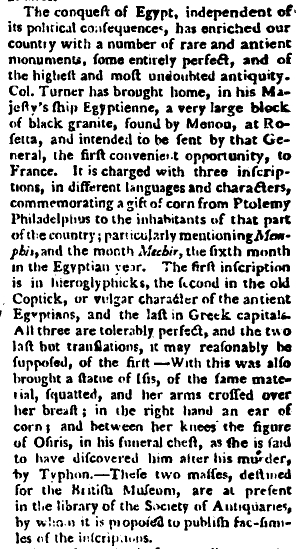Rosetta Stone
Rosetta Stone
The Rosetta Stone is an ancient granodiorite stele inscribed with a decree issued in Memphis, Egypt in 196 BC during the Ptolemaic dynasty on behalf of King Ptolemy V. The decree appears in three scripts: the upper text is Ancient Egyptian hieroglyphs, the middle portion is Demotic script, and the lowest is Ancient Greek. Because it presents essentially the same text in all three scripts (with some minor differences among them), the Rosetta Stone provided the key to the modern understanding of Egyptian hieroglyphs.
Discovery[edit | edit source]
The Rosetta Stone was discovered in 1799 by a French soldier named Pierre-François Bouchard during the Napoleonic campaign in Egypt. It was found in the town of Rosetta (Rashid), about 35 miles east of Alexandria. The stone was later seized by British forces and transported to London, where it has been on public display at the British Museum since 1802.
Significance[edit | edit source]
The Rosetta Stone's significance lies in its role in deciphering Egyptian hieroglyphs. Before its discovery, the meaning of hieroglyphs had been lost for centuries. The stone's trilingual inscription allowed scholars, most notably Jean-François Champollion, to make significant progress in understanding the ancient script. Champollion's work, published in 1822, laid the foundation for the field of Egyptology.
Description[edit | edit source]
The Rosetta Stone is approximately 114 cm high at its tallest point, 72 cm wide, and 28 cm thick. It weighs about 760 kg. The text on the stone is a decree that affirms the royal cult of Ptolemy V on the first anniversary of his coronation. The decree was issued by a congress of priests who gathered at Memphis.
Inscriptions[edit | edit source]
The inscriptions on the Rosetta Stone are divided into three sections:
- The top section, written in Egyptian hieroglyphs, was intended for the priests.
- The middle section, written in Demotic script, was the native script used for daily purposes by the literate class.
- The bottom section, written in Ancient Greek, was the language of the administration.
Decipherment[edit | edit source]
The process of deciphering the Rosetta Stone began soon after its discovery. Scholars such as Thomas Young and Jean-François Champollion played crucial roles in this endeavor. Young made initial progress by identifying the names of Ptolemy and Cleopatra in the Greek and hieroglyphic texts. Champollion built on Young's work and eventually deciphered the entire hieroglyphic text by comparing it with the Greek and Demotic versions.
Current Location[edit | edit source]
The Rosetta Stone is currently housed in the British Museum in London. It is one of the most visited objects in the museum and remains a symbol of linguistic and cultural discovery.
Related Pages[edit | edit source]
- Ancient Egypt
- Hieroglyph
- Demotic (Egyptian)
- Ancient Greek
- Jean-François Champollion
- British Museum
- Ptolemaic dynasty
- Pierre-François Bouchard
- Thomas Young (scientist)
See Also[edit | edit source]
References[edit | edit source]
External Links[edit | edit source]
Search WikiMD
Ad.Tired of being Overweight? Try W8MD's physician weight loss program.
Semaglutide (Ozempic / Wegovy and Tirzepatide (Mounjaro / Zepbound) available.
Advertise on WikiMD
|
WikiMD's Wellness Encyclopedia |
| Let Food Be Thy Medicine Medicine Thy Food - Hippocrates |
Translate this page: - East Asian
中文,
日本,
한국어,
South Asian
हिन्दी,
தமிழ்,
తెలుగు,
Urdu,
ಕನ್ನಡ,
Southeast Asian
Indonesian,
Vietnamese,
Thai,
မြန်မာဘာသာ,
বাংলা
European
español,
Deutsch,
français,
Greek,
português do Brasil,
polski,
română,
русский,
Nederlands,
norsk,
svenska,
suomi,
Italian
Middle Eastern & African
عربى,
Turkish,
Persian,
Hebrew,
Afrikaans,
isiZulu,
Kiswahili,
Other
Bulgarian,
Hungarian,
Czech,
Swedish,
മലയാളം,
मराठी,
ਪੰਜਾਬੀ,
ગુજરાતી,
Portuguese,
Ukrainian
Medical Disclaimer: WikiMD is not a substitute for professional medical advice. The information on WikiMD is provided as an information resource only, may be incorrect, outdated or misleading, and is not to be used or relied on for any diagnostic or treatment purposes. Please consult your health care provider before making any healthcare decisions or for guidance about a specific medical condition. WikiMD expressly disclaims responsibility, and shall have no liability, for any damages, loss, injury, or liability whatsoever suffered as a result of your reliance on the information contained in this site. By visiting this site you agree to the foregoing terms and conditions, which may from time to time be changed or supplemented by WikiMD. If you do not agree to the foregoing terms and conditions, you should not enter or use this site. See full disclaimer.
Credits:Most images are courtesy of Wikimedia commons, and templates, categories Wikipedia, licensed under CC BY SA or similar.
Contributors: Prab R. Tumpati, MD






